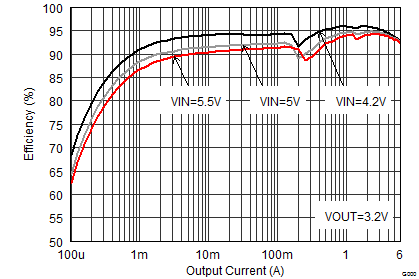SLVSDT1C July 2017 – June 2020 TPSM82480
PRODUCTION DATA.
- 1 Features
- 2 Applications
- 3 Description
- 4 Revision History
- 5 Pin Configuration and Functions
- 6 Specifications
- 7 Detailed Description
- 8 Application and Implementation
- 9 Power Supply Recommendations
- 10Layout
- 11Device and Documentation Support
- 12Mechanical, Packaging, and Orderable Information
Package Options
Mechanical Data (Package|Pins)
- MOP|24
Thermal pad, mechanical data (Package|Pins)
Orderable Information
8.2.3 Application Curves
VIN= 3.6 V, VOUT = 1.8V (R1 / R2 = 240 kΩ / 120 kΩ), TA = 25°C, MODE = Low, (unless otherwise noted)

| VOUT = 3.2 V |

| VOUT = 1.8 V |

| VOUT = 0.9 V |

| MODE = High | ||
(Load Regulation)

| VOUT = 0.6 V |

| VOUT = 2.5 V |

| VIN = 6 V (battery supply) | RLOAD = 0.33 Ω | VOUT = 1.8 V |
| EMI test board without filters | VSEL Low | |

| VOUT = 1.8 V | ||

| VOUT = 2.5 V | no load | |



Load Step 0 to 3 A

Load Step 3 to 6 A

| Cff = 36 pF (nom) | ||
Load Step 0 to 6 A

| VIN = 5 V | VOUT = 3.3 V |
(TPSM82480 EVM)

| VOUT = 3.2 V |

| VOUT = 1.8 V |

| VOUT = 0.9 V |

| MODE = High | ||
(Line Regulation)

| VOUT = 5.5 V |

| VOUT = 1 V |

| VIN = 6 V (battery supply) | RLOAD = 0.47 Ω | VOUT = 2.5 V |
| EMI test board without filters | VSEL High | |

| VOUT = 1.8 V | ||

| VOUT = 1 V | no load | |

| IOUT = 50 mA | ||


| Cff = 36 pF (nom) | ||
Load Step 0 to 3 A

| Cff = 36 pF (nom) | ||
Load Step 3 to 6 A

| IOUT = 10 A | ||

| VIN = 5 V | VOUT = 3.3 V | IOUT = 6 A |